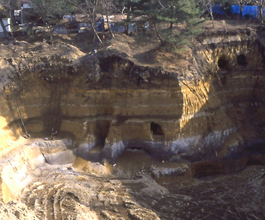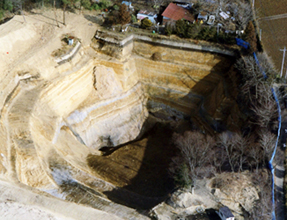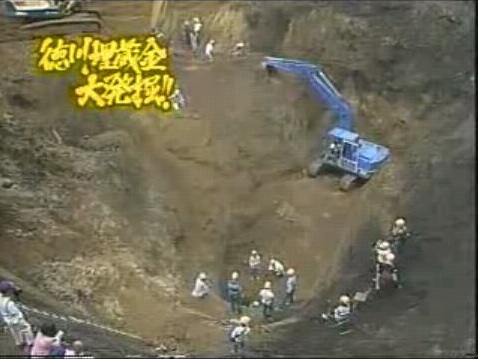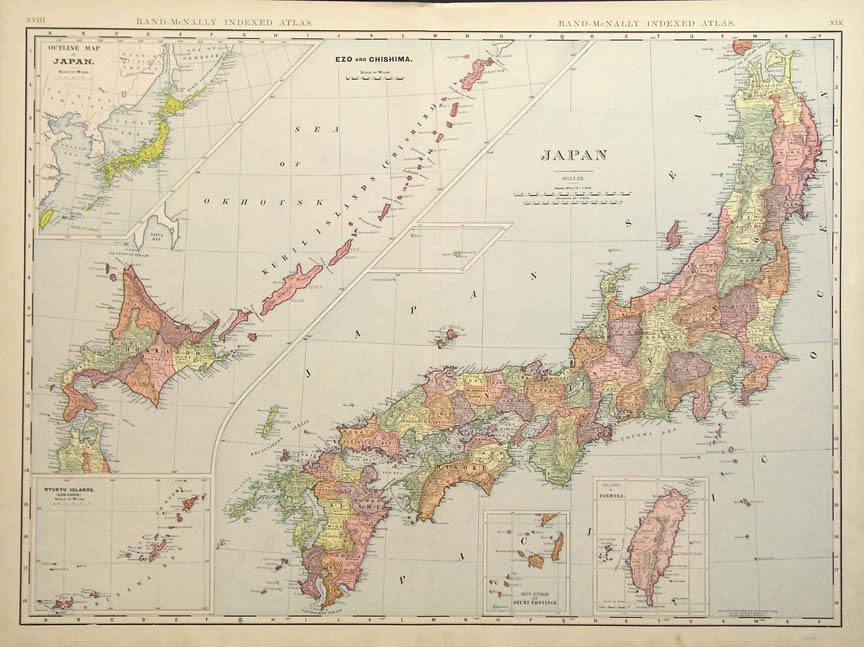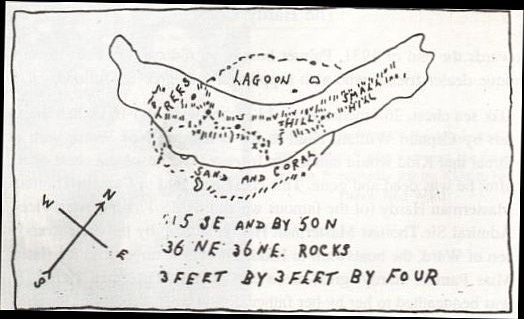Partially, the reason why this side of the grand puzzle was dropped can be explained by the conflagration that engulfed the globe known as World War 2, with the eastern seas falling under the glare of the Rising Sun.
In ‘Pirate Treasure’ (1937) and ‘Modern Buried Treasure Hunters’ (1934) Wilkins related the story of the ‘Hong Kong Pilot’. Wilkins gave another recognitive clue by copying another related story; yet this other story is deliberately excluded from his other books.
He began the ‘Hong Kong Pilot’ story with:
“In ports all over the Eastern Seas, from Singapore and Manila, to Yokohama to Frisco, you will find today seafarers who are sure they know of caches of immense treasure ashore on lonely beaches and desolate islands, or sunken bullion wrecks in the waters of the South Pacific or off China. They have seen the old charts with the imprints of Mr. Bill Bones, master of the Walrus of Savannah, who sailed the seas under captain Flint, or crude sea-stained maps bearing the anchor-his-mark of Israel Hands, who begged his bread in the streets of Old Wapping, what time poor Kidd hung in chains at Execution Dock. Sometimes these yarns have a foundation of fact. The treasure-seekers are not always unscrupulous adventurers or tattooed whisky swallowers. A pilot, well-known in Hong Kong, for his skill and business ability, once possessed a chart of a sunken ship of a most convincing nature.”
This is just a reworking of the opening narrative of ‘The Treasure of Don Bruno’ by Louis Becke (1897),
“Many hundreds of tales have been written about the discovery of buried treasure, and the wise people of today laugh and shake their heads when some boy, pondering over an exiting treasure story in which doubloons, and pieces of eight, and pirates, and buccaneers inflame his imagination, asks someone “If any part of it all is true.” Yet, although ninety-nine out of a hundred of such tales may be, and probably are, purest fiction, treasure has been found, not only in the haunts of the old-time pirates of the Caribbean Sea and the Spanish Main, but in both the North and South Pacific Oceans; and the story of the finding of the treasure of Bruno do Bustamente on an island in the North Pacific is true-true in every detail as here narrated, save the name of one of those who found it has been changed. He was an Englishman, and less than thirty years ago was well known in the Southern Colonies as the chief officer of a steamer trading between Sydney, Hobart, and Melbourne.”
This pilot had obtained a small chart of ‘a crude drawing of a coral reef and shoal, north-east of the Philippines’ where a Spanish galleon on route from Lima to Manila had foundered on a reef late 17th century. The chart had come from a ‘Captain Salmon’, who had obtained it in the Philippines circa 1850. Dying, Captain Salmon gave the chart to his employer. The employer, after wrecking and losing everything, sold the chart for a pittance to the Hong Kong Pilot.
The story of the ‘Hong Kong Pilot’ by Wilkins is to be read as a clue that says, ‘Look for something to the northeast of the Philippines that you will recognize.’
The area north east of the Philippines can be said to be centered approximately around the bearings 19º North and 139º East (of Greenwich). These bearings can be immediately recognized as those of the Pinaki Trinity but hemispherically reversed.
But an event during the period leading up to the outbreak of war involving Wilkins and his maps was the main cause of his activity being halted. The W2 Mar Del map was stolen from Wilkins in 1938 by ‘Japanese fishermen alias secret service men’, as Wilkins informs us in his ‘Panorama of Treasure Hunting’. The map, the author subsequently learnt via a Reuters telegram from Tokyo, was used by the ‘fishermen’ on a vain hunt for the treasure island, which was thought to now be in Japanese territorial waters.
Wilkins finished with this admonition,
“All is not as it seems my dear negrito Asiatics of chrysanthemum and cherry blossom land, and if, once again, you blandly and honourably plow the author’s pastures, you will find that it is for your coulters, rather a sterile soil. We Occidentals, have a proverb: A Woman does not tell all she knows of a secret.”
This incident was however more than disconcerting for Wilkins for this map was not merely for Captain Kidd’s mythical treasure but actually contained clues integral to locating the great lost treasure. The stereotypical image portrayed by Wilkins of 1940’s Hollywood style Japanese spies was not accurate either. In fact the Japanese were trying to find something that the Emperor sought and which Wilkins was now known to be publishing coded clues for.
Perhaps they had seen the clue that Wilkins had put as a pointer on his Mar Del maps 1 & 2: LAT DMD. This is 500 1000 500 or the 515 pointer Skelton misdirected everyone to. No one else seemed to pick this up though. Which is why Wilkins used it again later for his work at Rennes le Chateau.
The reason the Japanese were interested in the maps is that they had been searching for the treasure on the mainland of Japan since the 1880s.
The Tokugawa Treasure
It is more than likely you have never heard of the treasure legend known as the Tokugawa Treasure. Few people are even aware of the story outside of Japan. Within Japan this legend has so captured the imagination of the Japanese populace that many searchers continue to actively seek it today driven by numerous articles, books and documentaries on the subject. In times of economic downturn there is an increase in activity to find this treasure as a last ditch hope by out of work salary men. The trouble is, like all the related stories, it’s just a big mistake. It’s the result of the activities of a single American who, sometime around the 1880s, followed the codes and monument map to seek out the treasure on the slopes of Mt Akagi. Why this story is important and is being given last is because it confirms that the map and the codes did direct others to seek the treasure on the Cero Tres Puntas found at 139 degrees longitude. Is that longitudinal value familiar?
The story will be given as it is told in Japan now so you can first learn the details then work out what really happened. If the story is a bit vague on details it’s not because of the lack of versions of it in English, it’s because the whole thing actually is very vague on the details. This lack of detail doesn’t stop searchers in Japan though.
The story is set during the era of Meiji Restoration in Japan, the 1860s. The source of the gold in the story is said to originate from some Tokugawa Shogun, hence its name. General versions of the story name Oguri Tadamasa, a servant to one of the shoguns, as being involved with the cache. The stories revolve around Oguri being tasked by some shogun or official to cache gold as a contingent fund in opposing the ascending Meiji government.
It’s the more explicit (and most reported) version we are interested in. This version begins with Mizuno Tomoyoshi who was born in 1851, one of a number of sons of a Tokugawa administrator. In 1887 Tomoyoshi received a deathbed letter from Nakajima Kurando, an old neighbour who had some type of avuncular relationship with the boys. According to the letter, in 1868, Nakajima helped transport two shipments of gold, one from Kai and one from Edo to cache it on Mt Haruna. When Nakajima had returned for the gold it had been moved and he now believed it was on Mt Akagi. Find the gold Tomoyoshi!
Tomoyoshi, who is described as some type of Tokyo real estate merchant, sells his business and begins to excavate Mt Akagi in 1888 to find the gold. These excavations have now been carried on for four generations, the latest being Mizuno Tomoyuki also attempted to decipher the instructions left to him as he excavated various locations. He had a scroll from his grandfather about the treasure and he proved its authenticity for various reporters by producing the police receipt issued when the scroll was returned after it was stolen around 1898.
Let’s examine a few things to work out what this was all really about:
1. Oguri Tadamasa was a real person, a high ranking administrator who, after arguing the shogunate should oppose the Meiji forces, was sacked by his shogun in 1868. Oguri and his household left Edo and traveled to Gonda in Gunma Prefecture. In Gonda, bandits with the aid of villagers attacked Oguri and his retinue believing he was carrying military funds. He defeated the attack but was afterwards captured by Meiji forces and executed.
2. Nakajima Kurando was supposed to be an investigator in the financial magistrate. There are no records of him being in the financial magistrate. There are no records of him existing at all apart from what is told by Mizuno.
3. In Gunma prefecture is to be found the Jomo Sanzan. ‘Jomo’ is the old name of the area now known as Gunma Prefecture. ‘Sanzan’ means three mountains. Here is the symbol for Gunma Prefecture. It shows the three sacred mountains of Mt Akagi, Mt Haruna and Mt Myogi. These are at the longitude 139ºE (of Greenwich).
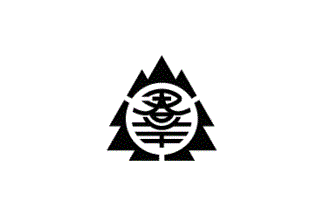
You also need to learn what happened in the area in the latter half of the 19th century that was so unusual that the locals still give accounts of it. This was the period of the opening up of Japan to the west. The sight of Westerners in coastal trading areas was becoming common but for those Japanese inland where the Jomo Sanzan are located the appearance of any westerner was still an unusual event. When an American turned up and began to excavate the land he bought on Mt Akagi looking for a treasure the locals became curious. As the Japanese themselves were only able to buy and sell land from 1872 and foreigners only allowed to do so from around 1890 this meant the mysterious American had some kind of permission from the authorities to carry out his work. Of course it all comes down to our friends the Freemasons again whose lodges were active in Japan. They were in positions of influence as they were the western emissaries and businessmen who were advising the Japanese government on the process of modernising the country.
As a result of the Treaty of Amity and Comity made in 1858 Japan and its port of Yokohama in 1859 opened to the West. The first established Masonic Lodge, the Sphinx Lodge No. 263, was operational in Japan from 1864 when a detachment from the 2nd Battalion of the 20th Regiment of Foot (Lancashire Fusiliers) took up garrison duties in Yokohama. Westerners now resident in Japan then desired to establish their own truly local lodge. Their toil resulted in the first meeting of the Yokohama Lodge No. 1092 E.C. on 26th of June 1866.
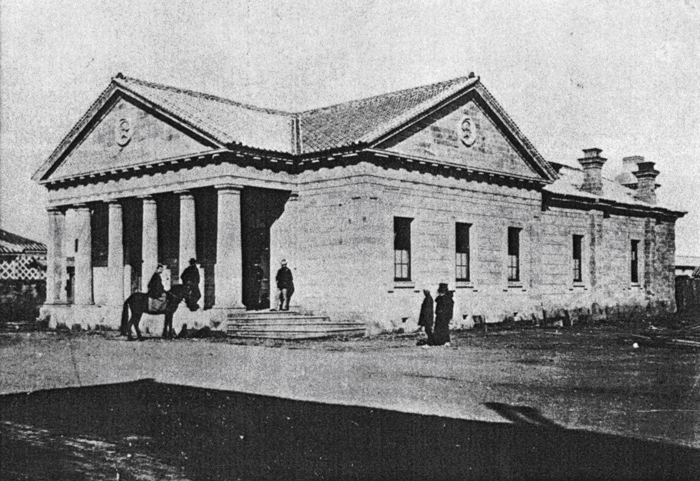
In 1868 Japanese authorities allotted the plot of land at Number 170 Yamashitacho for the use of the Freemasons to build a Temple. The foundation stone was laid on 1 March 1869. Its solid construction was reported favourably on as it survived an earthquake in 1870 without so much as a crack. Facilitating access then for one of their Brothers to excavate one of the sacred mountains of the Jomo Sanzan was no real problem. The Jomo Sanzan was after all the Cero Tres Puntas on the 139 longitude that they had misheard/misunderstood as ‘Cerro Tres Puntas’.
What this means is that in another of the great reversals of understandings that make up story of this great lost treasure this mysterious American was not following the legend of the Tokugawa Treasure, he was responsible for creating it.
The legend as it appears now in Japan is quite recognizable so you can tell the mysterious American did give quite a lot of the story to the locals. Oguri Tadamasa somewhat equates to Ubilla in the action of hiding the gold in defiance of a change in the ruling power of the country. Kurando Nakajima is a mixture of both Ubilla and Webb in that he hides the gold and when dying leaves details about it.
Of course Kurando Nakajima didn’t exist. Mizuno Tomoyoshi made this up because it’s nothing to do with a Tokugawa treasure, it’s just another version of the story again. Likewise the inclusion about him being the recipient of the death bed letter is false also. The version he gave does have the relocation detail in it (here Mt Haruna to Mt Akagi) so he was close to who told the story originally. How close? It is said he was a real estate agent in Tokyo. He probably facilitated the sale of land on Mt Akagi to the American. Who else do you think told him the story of the treasure and provided the unique detail that the treasure had been ‘relocated’ from Mt Haruna to Mt Akagi? According to the Webb report the treasure had been relocated, remember? The protagonist’s names were never given to him either, only the story. That is why Japanese names have been added to it.
Luckily the Freemasons were off the mark. They were using the monument map completely in reverse. You will have noticed that from the datum point of 19N 138E it’s not 115 degrees that takes you to the Jomo Sanzan in Japan, it’s more around 130 degrees. Still, if you had the monument map and were after the ‘Cerro Tres Puntas’ on the 139 longitude, between seeing the shape of the island of Honshu and learning of the Jomo Sanzan you would have thought you had finally found the right three mountains. The problem with these mountains is they are not in the required triangular layout. They are just near each other in the Gunma Prefecture and the best you can do is play join the dots to connect them in a line.
Which brings us back to Harold T Wilkins. As part of the Kidd puzzle he drew the 1932 map that depicts the monument map shape with some connected dots shown along the top of what looks like a mountain range.
Did you know the Japanese are actually Hebrews?
Jenichiro Oyabe (1867-1941), in 1885 as a Meiji era gentleman, left his homeland of Japan to travel and learn until his return in 1898. His autobiography, ‘A Japanese Robinson Crusoe’ details his conversion to Christianity and his travels to China, Russia, Okinawa, the South Seas and America where he attended Howard then Yale Universities to become a man of letters. He is best remembered for his anthropological studies and emissarial work amongst the Ainu, the aboriginal inhabitants of the Japanese island of Hokkaido. The title of his 1929 book ‘Nihon oyobi Nihon kokumin no kigen: kodai Nihonjin wa Heburaijin nari’ which was ‘Japan and the origins of the Japanese people, the ancient Hebrew people’, says it all. This book was issued with two red seals announcing the ‘Bestowal of the Royal Reading.’ On the front cover was imprinted a gold Star of David within which Hebrew lettering spelt out the phrase “The Voice of God”. This interesting claim made by Oyabe was taken rather seriously as the seals of Royal Reading announced. It also had something to do with the reason why Japanese “secret service men” stole one of Wilkins’ made up Kidd maps and why the whole eastern limb of the Kidd chart riddle which had taken Wilkins and his associates over ten years to propagate was quietly dropped.
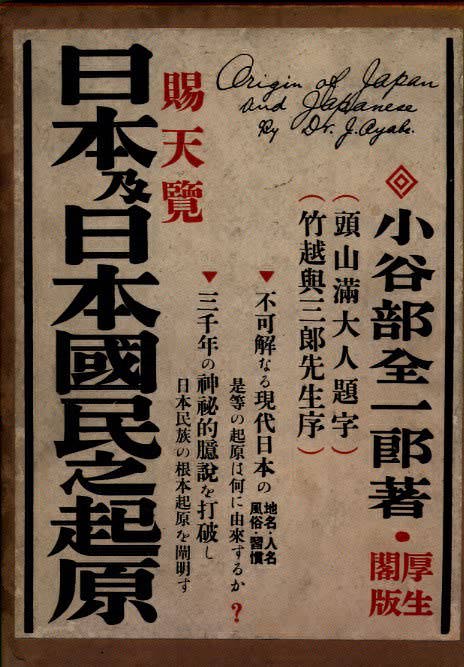
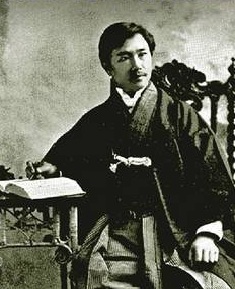
Jenichiro Oyabe’s 1929 declaration via his book that the Japanese people were descendants of the Hebrews (therefore the Emperor was truly a divine sovereign) was just another example of those who, believing the treasure of God to be within their grasp, asserted their right to rule through it.
Grasping for the treasure was indeed done during the decade pre World War II s especially when a series of treasure maps suggestive of the shape of Japan began to come to light. These treasure maps were in conjunction with writings that hinted and spoke of a lost treasure in the eastern seas. One of the maps in particular was very close in appearance to the main island of Honshu and depicted what looked like the tops of mountains in a mountain range. And it had measurements. With Japanese nationalism and imperialism running hot so too did interest in the vitally important treasure which westerners themselves believed conferred ultimate power. This treasure was somewhere in Japan!
The writer Harold T Wilkins, who was the source of the information about these strange maps and seemed to know more about it than he was letting on, became the unfortunate target of the Japanese ‘Secret Service’. After the map Wilkins drew for his Kidd book was stolen Wilkins realised that between what was already known and what he himself was releasing there would be more than enough directional clues for the Japanese to put ni and ni together and reverse engineer a complete set of working bearings to find the true Cero Tres Puntas. As a result he quickly and quietly dropped anything to do with his Kidd puzzle for the treasure.
An even bigger 'Whoops' than Oak Island; the staggering scale of Japanese excavations today trying to find the treasure
